
- •Lesson (1) Chromosomes and genetic information
- •Remember
- •Remember
- •Importance of crossing over:-
- •Lesson (2) The interaction of genes
- •Remember
- •Remember
- •Inheritance of blood groups in human
- •For illustration only
- •Inheritance of colour trait in mice
- •Inheritance of chlorophyll absence trait in corn plant
- •Lesson (3) Genetic inheritance and diseases
- •Importance of pedigree
- •Answer four questions only
Lesson (2) The interaction of genes
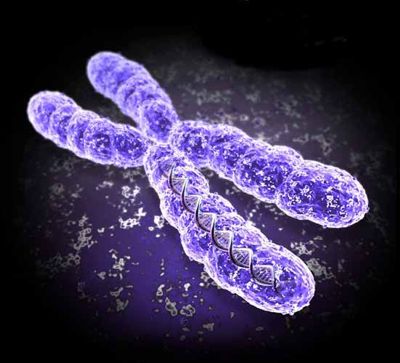
In 1860, Scientist Gregory Mendel discovered that every hereditary trait is controlled by a pair of genes, which may be dominant or recessive
Remember
Dominant trait: Trait which appears in all members of 1st generation
Recessive trait: Trait which disappears in all members of 1st generation and appears in 2nd generation at ratio 25%
Scientists discovered that there are many traits which are not inherited according to Mendel's laws, they are called Non-Mendilian traits. There are some cases of non-Mendilian traits in which the appearance of hereditary traits is affected by the interaction of genes.
Examples of genes interaction: Lack of dominance – Complementary genes – Lethal genes.
Remember
Each pair of contrasting traits is called "Allelomorphic traits"
According to Mendel, when two pure individuals (one of them carries a dominant trait, while the other carries recessive trait) copulate, Only the dominant trait appears in the individuals of 1st generation, while it appears with recessive trait in the individuals of 2nd generation at ratio 3 dominant : 1 recessive

Flowers of Four o'clock plants have three colours: Red – White – Pink

Fig. (1) Four o'clock plant
When a plant with white flowers (WW) copulates with another one of red flowers (RR), they produce 100% plants with pink flowers (RW) in the first generation.
In 2nd generation, red, pink and white flowers appear at ratio 1:2:1
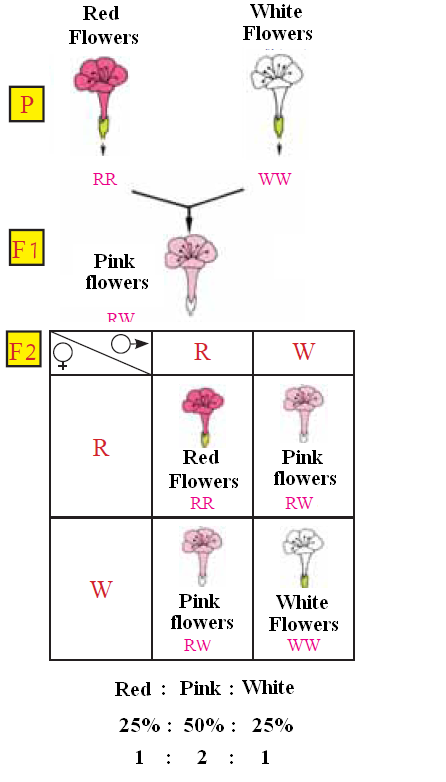
We conclude from the following figure:-
The colour of flower trait (Red or white) is
controlled by two genes which do not dominate
over each other.
Those two gene interact together
, and every opposite gene participates
in the formation of a new trait (RW).
These results contradict with Mendel's
laws because no hereditary factor (gene)
dominates over the other one, which forms
plants of ratio 1:2:1 instead of 1:3 in the 2nd
generation. But the two genes interact forming
new gene, which is known as lack of dominance
Note: in lack of dominance case, the phenotype
describe genotype
Genotype: The structure of gene in living organism
Phenotype: The hereditary trait appearing on
Living organism.
The gene responsible for eye colour is genotype,
While the colour of eye trait is phenotype
Inheritance of blood groups in human
Although the components of blood are constant in
all humans, they have different blood groups
Blood transfusion process depends on blood group
and kind of Rhesus factor
Blood groups trait is controlled by three kinds of genes called Alleles, these alleles are denoted by (A – B – O ). Each person inherits only one pair of Alleles.
This pair of alleles exist on chromosome pair (9) in all humans.
Allele (For illustration only) : Alternative forms of the same gene which produce different effects.
Genetic classification of blood groups
Blood groups share three inheritance types, which are:-
- Alleles multiplicity:-
Blood groups trait is controlled by 3 alleles (A – B – O)
Human inherits only one pair of them
-
Genotype (genetic structure)
Blood group
AA or AO
A
BB or BO
B
AB
AB
OO
O
- Complete dominance: Both of genes (A) and (B) dominate over gene (O)
- Lack of dominance: There is no dominance between genes (A) and (B), but they participate in the formation of a new group (AB)
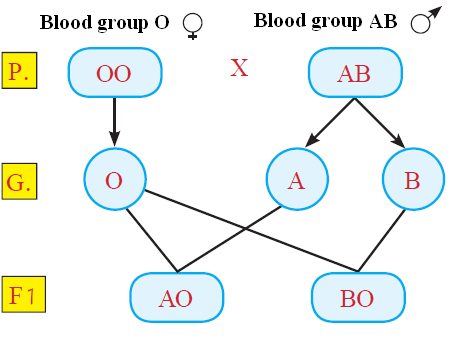
Fig. (2) Blood group inheritance
From the previous figure, we conclude that 50% of children will have blood group (A), and the other 50% will have blood group (B)
Chemical classification of blood groups:-
Blood groups (A – B – AB – O) classification depends on the kind of two substances in blood, which are:-
Antigens:-
They are chemical substances which exist on the surface of red blood cells (RBC), they have two kinds:-
1- Antigens a
2- Antigens b
Antibodies:-
T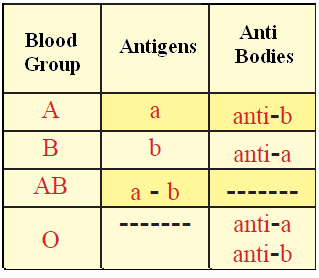 hey
are antibodies of antigens which exist in blood plasma, they have two
kinds:-
hey
are antibodies of antigens which exist in blood plasma, they have two
kinds:-
1- anti-a
2- anti-b
The importance of blood groups
1- Solving problems of the determination of paternity (parents of children) and pedigree of children (blood groups deny pedigree but don't prove it)
2- Determination of blood transfusion processes between individuals.
3- Used in the study of human races classification and evolution
Example
Two fathers argued about the pedigree of a child of blood type (O), if the blood types of both fathers is (O), the blood type of first man's wife is (A), and the second's wife (AB). Which one of those men is more likely to be the father of the child? Why?
Solution
Genetic analysis of the first man and his wife (N.B: genotype of blood type (A) is (AO) or (AA) – Genotype of blood type (O) is (OO)
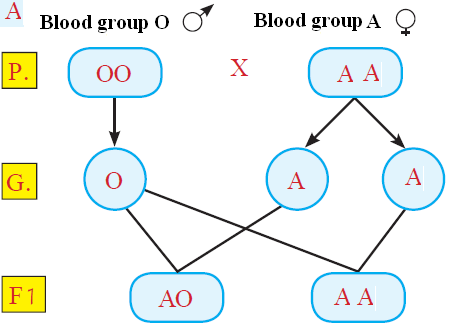
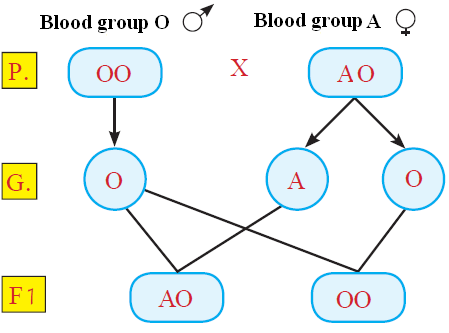
Genetic analysis of the second man and his wife (N.B: genotype of blood type (AB) is (AB) – genotype of blood type (O) is (OO)
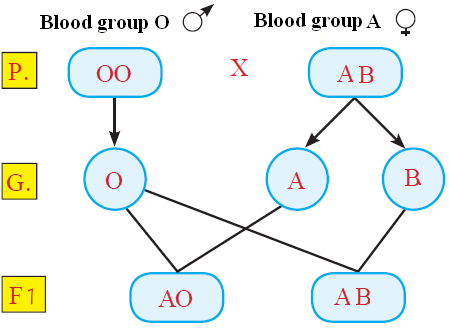
Therefore, the man who is married to the woman having (A) blood group is the father of the child
Blood transfusion process
Blood can be transfused between different blood groups according to the antigens and antibodies.
The following table describes blood groups and the probability of transfusing blood between them.

From the previous table, we conclude that:-
Blood group (AB) is called Universal Recipient because it can receive blood from all groups, as it doesn't have any antibodies.
Blood group (O) is called Universal Donor because it can give blood to all groups, as it doesn't have any antigens.
Determination of blood types
We said that antigens have antibodies (Ex. Antigen a has antibody a)
We can determine the type of blood by the reactions which occur between antigens and antibodies and the occurrence of blood coagulation (clotting)
Steps of determining blood type
1- Sample of blood is taken from the person.
2- We put two drops of blood on two clean glass sheets
3- We add (anti-a) antibodies to the first blood drop and (anti-b) antibodies to the second one.
4- We compare the result to the following table
Blood type |
Second blood drop (anti-b) |
First blood drop (anti-a) |
A |
- No coagulation ( - ) |
- Coagulation (+) |
B |
- Coagulation (+) |
- No coagulation ( - ) |
AB |
- Coagulation (+) |
- Coagulation (+) |
O |
- No coagulation ( - ) |
- No coagulation ( - ) |
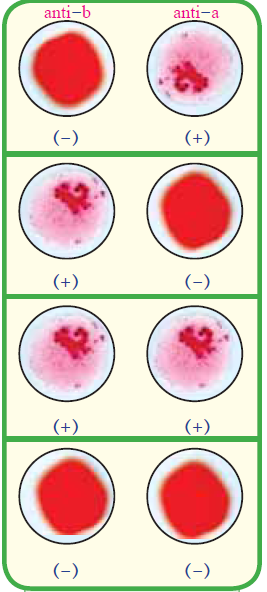
Fig. (3) Blood coagulation and blood group
Possible risks of blood transfusion
There are some risks which the recipient (who takes blood) may be exposed to:-
1- When a person receives blood which is not suitable for its type, some symptoms appear on him, such as :-
- Shivering in body
- Chest pain
- Blueness
- irregular heartbeat
- low blood pressure
- Shortness of breath
- Headache
This usually ends with the death of the person
2- Polluted blood may be transfused to the recipient person, which causes the infection with viruses (Ex. Hepatitis b virus – AIDS virus)
So, blood is being examined before transfusion process in order to make sure it is suitable for the recipient blood, and doesn't carry any pathogenic (disease-causing) organisms
Rhesus factor (Rh)
Blood carries two kinds of antigens, which are:-
- Antigens of blood group (a – b)
- Rhesus factor antigens
85% of humans have rhesus factor antigens in their blood, they are denoted by (Rh+) – positive rhesus factor
15% of humans don't have rhesus factor antigens in their blood, they are denoted by (Rh-) – negative rhesus factor
The inheritance of rhesus factors antigens is controlled by three pairs of genes carried on one chromosome pair.
A person becomes positive Rh factor (Rh+) if it has one or more dominant genes in each pair, while it becomes negative Rh factor (Rh-) if all its genes are recessive
